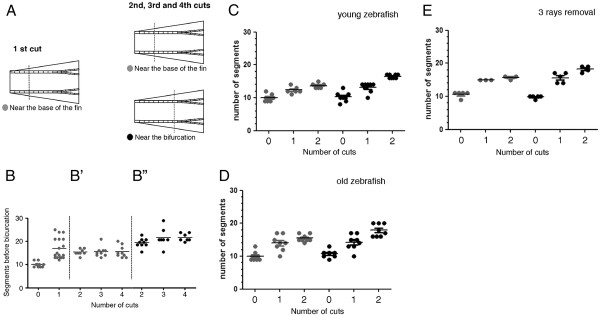Figure 2 .
The distalization of the bifurcation is dependent on the proximal-distal level of amputation. (A) After a first amputation performed at 4 segments from the base of the fin, the fish were divided into two groups. One group was amputated a second, third and fourth time at 4 segments from the base of the fin (near the base of the fin) and the second group was amputated at one segment below the most proximal bifurcation (near the bifurcation). (B) Number of segments formed in the 3rd dorsal ray between the base of the fin and the bifurcation after consecutive amputations performed always at 4 segments from the base of the fin (B’) and after a first amputation performed at 4 segments from the base of the fin followed by a second, third and fourth amputations near the bifurcation (B”). Number of segments formed between the base of the fin and the 3rd dorsal ray bifurcation after consecutive amputations performed at 4 segments from the base of the fin and at one segment below the most proximal bifurcation in 6 month old zebrafish (C) and in 1 year and 6 month of age zebrafish (D). (E) Number of segments formed between the base of the fin and the 4th dorsal ray after the removal of the 3rd, 4th and 5th bony rays at 4 segments from the base of the fin and at one segment below the most proximal bifurcation. Fins were allowed to completely regenerate for 2 weeks before the following amputation.

